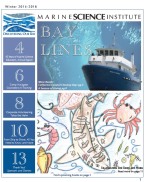In September, Marine Science Institute (MSI) hosted its sixth annual teacher event, “From Ship to Shore, All You Need to Know and More!” This year’s event focused on MSI’s program alignment with the Next Generation Science Standards (NGSS), which were adopted by California in 2013. Through mini workshops, an information table full of resources and conversations with dedicated staff, teachers learned about their options for providing NGSS-aligned, hands-on programs for their students.
Along with mapping out precise alignment with NGSS, MSI has been busy creating a whole new selection of thematic field trip and classroom program bundles, an approach we call “multiple-exposure programming.” Multiple-exposure programs provide a benefit for students; students are able to assimilate new knowledge over time by connecting to prior learning and activities. One of the programs highlighted at the teacher event was MSI’s Scientific Method Combination – Marsh and Beach Exploration for grades 4 and higher. Teachers were able to participate in program activities, including collecting data from a mock wrack line–a line of debris (both natural and human-made) left on the beach after high tide. During the Scientific Method Combination – Marsh and Beach Exploration program, students collect and catalogue debris found at the beach, and then create a graph to display the data. The activities incorporate many scientific practices, including asking questions, carrying out investigations, and collecting and analyzing data.
Another new multiple-exposure opportunity presented at the teacher event was our Biomimicry Program. The NGSS emphasize engineering design as an essential part of science education for all grade levels. MSI’s Biomimicry programs target engineering requirements for grades 3-12. Teachers at the event used different senses as they walked blindfolded, identifying functions and possible adaptations of things found in nature. This activity exemplified the first step of the biomimetic design process through which students learn how to observe and interpret lessons from the natural world. These activities were adapted from www.biomimicry.org.
The fun continued as teachers enjoyed delicious appetizers by the Bay with a glass of wine in hand, asking questions and test driving MSI’s new website. In 2016, MSI will launch a new and improved website through which teachers can search programs by grades, easily locate classroom activities and browse printable guides that show MSI program alignment with the NGSS
We hope that the teachers who attended our event enjoyed learning about our programs and walked away with new ideas and resources. It was a pleasure to host them. We’d like to thank Russian Ridge Winery for the wonderful wine donation; Jackie Siminitus, Dragon Productions, Go To Chocolate, Applebee’s and Aqui’sCalMex for some really great raffle prizes; MSI Board Members Jim Crawford, Sean Caplice and Michael Odai for funding the event; and,Oracle for the amazing volunteers!Finally, thank you, teachers, for your hard work all year-round.
If you are a teacher who is interested in adding marine science into your classroom
please contact our office at 650-364-2760 or by email at info@sfbaymsi.org
This article was featured in our BayLines Winter Edition 2015-2016.
Marine Science Institute is a tax-exempt 501(c)(3) not for profit organization
©2015. All Rights Reserved



Leave a comment